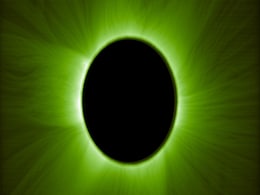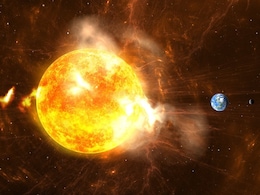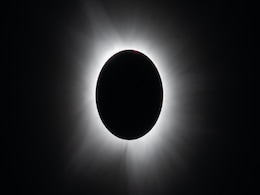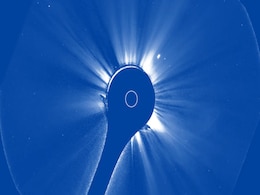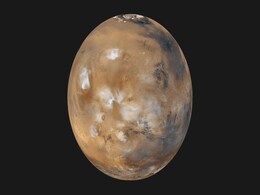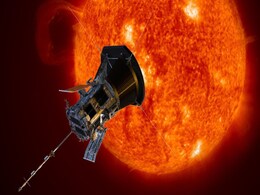Sun S Atmosphere
- All
- News
- Videos
-

Two Spacecraft Recreate Artificial Solar Eclipses to Observe the Sun’s Superhot Corona
- Friday June 27, 2025
- Written by Gadgets 360 Staff
Twin satellites in ESA’s Proba-3 mission have successfully recreated artificial solar eclipses from space to examine the sun’s million-degree corona. The breakthrough will allow continuous observations of the sun’s outer atmosphere, offering rare insights that natural eclipses on Earth can’t provide. The mission marks a major step in solar ...
-
 www.gadgets360.com
www.gadgets360.com
-

Why Are Sunsets So Pretty In Winter? There's A Simple Explanation
- Thursday June 12, 2025
- World News | The Conversation
If you live in the southern hemisphere and have been stopped in your tracks by a recent sunset, you may have noticed they seem more vibrant lately. The colours are brighter and bolder, and they linger longer in the sky.
-
 www.ndtv.com
www.ndtv.com
-

Solar Storms Are Causing Elon Musk's Starlink Satellites To Fall From The Sky
- Sunday June 8, 2025
- Science | Edited by Ritu Singh
The study revealed that geomagnetic storms caused by the Sun's eruptions increased atmospheric drag, causing satellites to re-enter faster than expected.
-
 www.ndtv.com
www.ndtv.com
-

Scientists Capture Plasma Streams, Coronal Raindrops in Sharpest-Ever View of Sun’s Corona
- Saturday May 31, 2025
- Written by Gadgets 360 Staff
For the first time, scientists have captured ultra-detailed footage of the sun’s outer atmosphere, showing coronal rain and a never-before-seen plasma stream. These new images were made possible by adaptive optics that cut through Earth’s atmospheric interference, revealing structures never observed before. The findings could unlock solar myste...
-
 www.gadgets360.com
www.gadgets360.com
-

Solar Eruptions Are Killing Off SpaceX's Starlink Satellites, NASA Study Reveals
- Wednesday May 28, 2025
- Science | Edited by Ritu Singh
The study found that solar storms cause satellites to re-enter the Earth's atmosphere faster than expected, reducing their lifespan by up to 10 days.
-
 www.ndtv.com
www.ndtv.com
-

Vernal Equinox 2025: Date, Time, and the Science Behind the Event
- Friday March 7, 2025
- Written by Gadgets 360 Staff
The vernal equinox 2025 is set for March 20 at 09:01 UTC, marking the astronomical start of spring in the Northern Hemisphere and autumn in the Southern Hemisphere. This event occurs due to Earth’s axial tilt aligning with its orbit, resulting in nearly equal hours of daylight and night across the globe. While the equinox does not bring perfectly...
-
 www.gadgets360.com
www.gadgets360.com
-

Aditya-L1’s SUIT Telescope Captures First-Ever Solar Flare Kernel, Revealing Unseen Solar Activity
- Friday March 7, 2025
- Written by Gadgets 360 Staff
India’s Aditya-L1 mission has achieved a historic milestone with its Solar Ultra-violet Imaging Telescope (SUIT) capturing the first-ever solar flare kernel in the near-ultraviolet spectrum. This unprecedented observation confirms energy transfer across different layers of the Sun's atmosphere, advancing the understanding of solar flares and spac...
-
 www.gadgets360.com
www.gadgets360.com
-

Study Finds Coronal Loop Flickers Could Predict Solar Flares Hours in Advance
- Friday January 17, 2025
- Written by Gadgets 360 Staff
NASA's Solar Dynamics Observatory has revealed a potential breakthrough in predicting solar flares. Scientists observed brightness fluctuations in coronal loops—plasma structures in the Sun's atmosphere—that intensify hours before solar flares occur. This discovery, with a prediction accuracy of 60–80%, may provide 2–6 hours of advance warn...
-
 www.gadgets360.com
www.gadgets360.com
-

NASA’s 2024 Solar Eclipse Studies Offer Key Insights on Sun-Earth Interactions
- Thursday December 12, 2024
- Written by Gadgets 360 Staff
NASA’s April 8, 2024, solar eclipse studies highlight the Sun's effects on Earth’s atmosphere, including corona changes, ionospheric impacts, and atmospheric gravity waves. Data from citizen scientists and research teams deepened the understanding of these interactions, as presented during the American Geophysical Union's annual meeting. Key fi...
-
 www.gadgets360.com
www.gadgets360.com
-

Solar 'Battle Zone' Could be Even Worse Than Solar Maximum, Experts Warn
- Friday December 6, 2024
- Written by Gadgets 360 Staff
Experts warn that the sun's next phase, the "battle zone," could result in increased geomagnetic activity, lasting until 2028. This period could bring heightened solar flares and coronal holes, which may cause disruptions to satellites in low-Earth orbit. Space weather experts, including Scott McIntosh from Lynker Space, have noted that this phase ...
-
 www.gadgets360.com
www.gadgets360.com
-

Solar Activity Increase Results in Shortens Lifespan of Binar CubeSats
- Tuesday November 26, 2024
- Written by Gadgets 360 Staff
Curtin University’s Binar CubeSats, launched with a six-month mission lifespan, re-entered Earth's atmosphere after only two months due to unexpectedly high solar activity. This surge in solar phenomena has increased atmospheric drag, impacting the stability of satellites in low Earth orbit. As solar forecasting remains limited, smaller satellite...
-
 www.gadgets360.com
www.gadgets360.com
-

Asteroids, Comets, and Meteors: What Makes Each Celestial Object Unique
- Wednesday November 20, 2024
- Written by Gadgets 360 Staff
NASA planetary scientists explain that asteroids, comets, and meteors all orbit the Sun but differ greatly in their composition, appearance, and behaviour. These objects play unique roles in understanding the solar system’s formation and evolution.
-
 www.gadgets360.com
www.gadgets360.com
-

NOAA's New Solar Telescope Captures Dramatic Footage of the Sun Spraying Huge Charged Particles
- Wednesday October 30, 2024
- Written by Gadgets 360 Staff
The National Oceanic and Atmospheric Administration (NOAA) has unveiled remarkable footage from the new Compact Coronagraph (CCOR-1), which is aboard the GOES-19 satellite. This advanced telescope captures charged particles and solar eruptions from the Sun’s corona, vital for monitoring solar activity as it approaches its peak in 2025. By blockin...
-
 www.gadgets360.com
www.gadgets360.com
-

Mars Loses Water Faster When Closer to the Sun, New Hubble and MAVEN Study Shows
- Tuesday September 17, 2024
- Written by Gadgets 360 Staff
Mars loses water faster when it is closest to the Sun, according to new data from the Hubble Space Telescope and NASA’s Mars Atmosphere and Volatile Evolution (MAVEN) mission. The rate of hydrogen loss in Mars' atmosphere increases significantly during perihelion, the point in its orbit closest to the Sun. This seasonal change has major implicati...
-
 www.gadgets360.com
www.gadgets360.com
-

NASA's Parker Solar Probe Unveils New Insights into Solar Heating Mystery
- Friday August 16, 2024
- NDTV
NASA's Parker Solar Probe has delivered groundbreaking insights into one of the sun's most perplexing mysteries: why its outer atmosphere, or corona, is significantly hotter than its surface. This phenomenon, known as the "coronal heating mystery," has puzzled scientists for decades. The Parker Solar Probe, which is the fastest human-made object, h...
-
 www.gadgets360.com
www.gadgets360.com
-

Two Spacecraft Recreate Artificial Solar Eclipses to Observe the Sun’s Superhot Corona
- Friday June 27, 2025
- Written by Gadgets 360 Staff
Twin satellites in ESA’s Proba-3 mission have successfully recreated artificial solar eclipses from space to examine the sun’s million-degree corona. The breakthrough will allow continuous observations of the sun’s outer atmosphere, offering rare insights that natural eclipses on Earth can’t provide. The mission marks a major step in solar ...
-
 www.gadgets360.com
www.gadgets360.com
-

Why Are Sunsets So Pretty In Winter? There's A Simple Explanation
- Thursday June 12, 2025
- World News | The Conversation
If you live in the southern hemisphere and have been stopped in your tracks by a recent sunset, you may have noticed they seem more vibrant lately. The colours are brighter and bolder, and they linger longer in the sky.
-
 www.ndtv.com
www.ndtv.com
-

Solar Storms Are Causing Elon Musk's Starlink Satellites To Fall From The Sky
- Sunday June 8, 2025
- Science | Edited by Ritu Singh
The study revealed that geomagnetic storms caused by the Sun's eruptions increased atmospheric drag, causing satellites to re-enter faster than expected.
-
 www.ndtv.com
www.ndtv.com
-

Scientists Capture Plasma Streams, Coronal Raindrops in Sharpest-Ever View of Sun’s Corona
- Saturday May 31, 2025
- Written by Gadgets 360 Staff
For the first time, scientists have captured ultra-detailed footage of the sun’s outer atmosphere, showing coronal rain and a never-before-seen plasma stream. These new images were made possible by adaptive optics that cut through Earth’s atmospheric interference, revealing structures never observed before. The findings could unlock solar myste...
-
 www.gadgets360.com
www.gadgets360.com
-

Solar Eruptions Are Killing Off SpaceX's Starlink Satellites, NASA Study Reveals
- Wednesday May 28, 2025
- Science | Edited by Ritu Singh
The study found that solar storms cause satellites to re-enter the Earth's atmosphere faster than expected, reducing their lifespan by up to 10 days.
-
 www.ndtv.com
www.ndtv.com
-

Vernal Equinox 2025: Date, Time, and the Science Behind the Event
- Friday March 7, 2025
- Written by Gadgets 360 Staff
The vernal equinox 2025 is set for March 20 at 09:01 UTC, marking the astronomical start of spring in the Northern Hemisphere and autumn in the Southern Hemisphere. This event occurs due to Earth’s axial tilt aligning with its orbit, resulting in nearly equal hours of daylight and night across the globe. While the equinox does not bring perfectly...
-
 www.gadgets360.com
www.gadgets360.com
-

Aditya-L1’s SUIT Telescope Captures First-Ever Solar Flare Kernel, Revealing Unseen Solar Activity
- Friday March 7, 2025
- Written by Gadgets 360 Staff
India’s Aditya-L1 mission has achieved a historic milestone with its Solar Ultra-violet Imaging Telescope (SUIT) capturing the first-ever solar flare kernel in the near-ultraviolet spectrum. This unprecedented observation confirms energy transfer across different layers of the Sun's atmosphere, advancing the understanding of solar flares and spac...
-
 www.gadgets360.com
www.gadgets360.com
-

Study Finds Coronal Loop Flickers Could Predict Solar Flares Hours in Advance
- Friday January 17, 2025
- Written by Gadgets 360 Staff
NASA's Solar Dynamics Observatory has revealed a potential breakthrough in predicting solar flares. Scientists observed brightness fluctuations in coronal loops—plasma structures in the Sun's atmosphere—that intensify hours before solar flares occur. This discovery, with a prediction accuracy of 60–80%, may provide 2–6 hours of advance warn...
-
 www.gadgets360.com
www.gadgets360.com
-

NASA’s 2024 Solar Eclipse Studies Offer Key Insights on Sun-Earth Interactions
- Thursday December 12, 2024
- Written by Gadgets 360 Staff
NASA’s April 8, 2024, solar eclipse studies highlight the Sun's effects on Earth’s atmosphere, including corona changes, ionospheric impacts, and atmospheric gravity waves. Data from citizen scientists and research teams deepened the understanding of these interactions, as presented during the American Geophysical Union's annual meeting. Key fi...
-
 www.gadgets360.com
www.gadgets360.com
-

Solar 'Battle Zone' Could be Even Worse Than Solar Maximum, Experts Warn
- Friday December 6, 2024
- Written by Gadgets 360 Staff
Experts warn that the sun's next phase, the "battle zone," could result in increased geomagnetic activity, lasting until 2028. This period could bring heightened solar flares and coronal holes, which may cause disruptions to satellites in low-Earth orbit. Space weather experts, including Scott McIntosh from Lynker Space, have noted that this phase ...
-
 www.gadgets360.com
www.gadgets360.com
-

Solar Activity Increase Results in Shortens Lifespan of Binar CubeSats
- Tuesday November 26, 2024
- Written by Gadgets 360 Staff
Curtin University’s Binar CubeSats, launched with a six-month mission lifespan, re-entered Earth's atmosphere after only two months due to unexpectedly high solar activity. This surge in solar phenomena has increased atmospheric drag, impacting the stability of satellites in low Earth orbit. As solar forecasting remains limited, smaller satellite...
-
 www.gadgets360.com
www.gadgets360.com
-

Asteroids, Comets, and Meteors: What Makes Each Celestial Object Unique
- Wednesday November 20, 2024
- Written by Gadgets 360 Staff
NASA planetary scientists explain that asteroids, comets, and meteors all orbit the Sun but differ greatly in their composition, appearance, and behaviour. These objects play unique roles in understanding the solar system’s formation and evolution.
-
 www.gadgets360.com
www.gadgets360.com
-

NOAA's New Solar Telescope Captures Dramatic Footage of the Sun Spraying Huge Charged Particles
- Wednesday October 30, 2024
- Written by Gadgets 360 Staff
The National Oceanic and Atmospheric Administration (NOAA) has unveiled remarkable footage from the new Compact Coronagraph (CCOR-1), which is aboard the GOES-19 satellite. This advanced telescope captures charged particles and solar eruptions from the Sun’s corona, vital for monitoring solar activity as it approaches its peak in 2025. By blockin...
-
 www.gadgets360.com
www.gadgets360.com
-

Mars Loses Water Faster When Closer to the Sun, New Hubble and MAVEN Study Shows
- Tuesday September 17, 2024
- Written by Gadgets 360 Staff
Mars loses water faster when it is closest to the Sun, according to new data from the Hubble Space Telescope and NASA’s Mars Atmosphere and Volatile Evolution (MAVEN) mission. The rate of hydrogen loss in Mars' atmosphere increases significantly during perihelion, the point in its orbit closest to the Sun. This seasonal change has major implicati...
-
 www.gadgets360.com
www.gadgets360.com
-

NASA's Parker Solar Probe Unveils New Insights into Solar Heating Mystery
- Friday August 16, 2024
- NDTV
NASA's Parker Solar Probe has delivered groundbreaking insights into one of the sun's most perplexing mysteries: why its outer atmosphere, or corona, is significantly hotter than its surface. This phenomenon, known as the "coronal heating mystery," has puzzled scientists for decades. The Parker Solar Probe, which is the fastest human-made object, h...
-
 www.gadgets360.com
www.gadgets360.com

